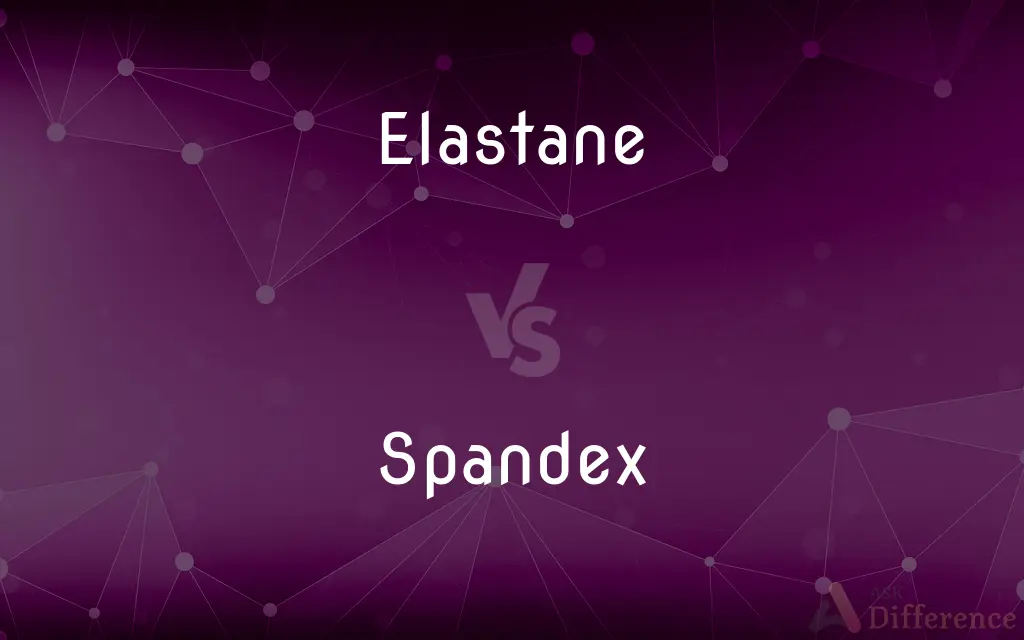Elastane vs. Spandex — What's the Difference?
By Tayyaba Rehman — Updated on September 18, 2023
Elastane and Spandex are two names for the same synthetic fiber known for its exceptional elasticity. The primary difference is regional terminology.

Difference Between Elastane and Spandex
Table of Contents
ADVERTISEMENT
Key Differences
The world of textiles introduces us to a vast array of materials, among which are Elastane and Spandex. However, these are not two distinct fibers; rather, they are two names for the same material, the primary distinction being the terminology used in different regions.
Both Elastane and Spandex refer to a synthetic fiber renowned for its remarkable elasticity. The naming difference is primarily due to regional preferences. In most parts of the world, including Europe, the term Elastane is predominantly used, while Spandex is the preferred term in North America.
The choice of term doesn't alter the fiber's characteristics. Both Elastane and Spandex are integrated into various clothing items to provide stretch. This shared property ensures garments fit snugly, offering both comfort and shape retention.
It's essential to recognize that regardless of whether a label mentions Elastane or Spandex, the inherent qualities and care instructions remain consistent. Both terms describe a material resistant to body oils, perspiration, and detergents.
In summary, while Elastane and Spandex might seem like different materials based on their names, they refer to the exact same synthetic fiber. The choice of name purely depends on the region or market.
ADVERTISEMENT
Comparison Chart
Terminology Origin
Commonly used in Europe and other parts of world.
Predominantly used in North America.
Material Property
Synthetic fiber known for elasticity.
Synthetic fiber known for elasticity.
Usage in Clothing
Used to provide stretch in garments.
Used to provide stretch in garments.
Resistance
Resistant to body oils, perspiration, detergents.
Resistant to body oils, perspiration, detergents.
Context of Usage
Labels in European products.
Labels in North American products.
Compare with Definitions
Elastane
A fiber resistant to body oils and detergents.
The Elastane in this shirt prevents it from sagging.
Spandex
A synthetic material famous for its stretchiness.
Leggings made of Spandex are incredibly comfortable.
Elastane
A synthetic fiber known for its high elasticity.
These jeans contain 2% Elastane for added stretch.
Spandex
A durable fiber that retains its shape and elasticity.
Despite multiple washes, the Spandex shorts haven't lost their shape.
Elastane
Often blended with other materials to improve fit.
This dress is made of cotton and Elastane.
Spandex
Often mixed with other fabrics to offer stretch.
The Spandex content in these jeans makes them fit perfectly.
Elastane
The primary material used in stretchable clothing.
Elastane ensures the swimsuit fits snugly.
Spandex
The primary component in many form-fitting garments.
This Spandex bodysuit is perfect for my dance performance.
Elastane
The European term for the synthetic fiber Spandex.
European brands often list Elastane on their garment labels.
Spandex
The North American term for the synthetic fiber Elastane.
American brands typically use the term Spandex on their tags.
Elastane
An elastic polyurethane material, used for hosiery, underwear, and other close-fitting clothing.
Spandex
Spandex, Lycra, or elastane is a synthetic fiber known for its exceptional elasticity. It is a polyether-polyurea copolymer that was invented in 1958 by chemist Joseph Shivers at DuPont's Benger Laboratory in Waynesboro, Virginia, US.The generic name "spandex", which is an anagram of the word "expands", is the preferred name in North America.
Elastane
Spandex, lycra.
Spandex
A type of stretchy polyurethane fabric
Gold spandex leggings
Spandex
A synthetic fiber or fabric made from a polymer containing polyurethane, used in the manufacture of elastic clothing.
Spandex
Of or relating to spandex or its elastic qualities.
Spandex
A synthetic fibre known for its exceptional elasticity.
Spandex
Clothing made from such material.
Spandex
An elastic textile material, used for clothing
Spandex
An elastic synthetic fabric
Common Curiosities
What's the primary characteristic of Spandex?
Spandex is known for its exceptional elasticity.
Why is Elastane added to clothing?
Elastane is added to garments to provide stretch, ensuring a snug fit and comfort.
Is Spandex natural or synthetic?
Spandex is a synthetic fiber.
Are Elastane and Spandex different materials?
No, Elastane and Spandex refer to the same synthetic fiber; the name difference is regional.
Are care instructions different for Spandex and Elastane clothing?
No, the care instructions are the same since they are the same material.
Can Elastane garments be machine washed?
Yes, but it's best to follow the specific care instructions on the clothing label.
Are there any allergies associated with Spandex?
Allergies to Spandex are rare but possible. It's advisable to consult with a doctor if irritation occurs.
Why are sportswear often made with Spandex?
Sportswear uses Spandex for its flexibility, allowing athletes free movement.
Where is the term Elastane predominantly used?
Elastane is mainly used in Europe and several other parts of the world.
How is the elasticity of Spandex compared to natural fibers?
Spandex offers superior elasticity compared to most natural fibers.
Can I iron Elastane clothing?
It's best to avoid direct ironing on Elastane; use low heat and a cloth barrier if necessary.
Does Elastane degrade over time?
While Elastane is durable, prolonged exposure to chlorine and sunlight can weaken its elasticity.
Why do some labels mention both Elastane and Spandex?
Some international brands mention both to cater to a global audience.
Can I find 100% Elastane garments?
It's rare to find 100% Elastane garments; it's typically blended with other materials for comfort and durability.
Is Elastane breathable?
While Elastane itself isn't very breathable, it's often blended with breathable fabrics like cotton to enhance comfort.
Share Your Discovery

Previous Comparison
Staring vs. Starring
Next Comparison
Realist vs. RealestAuthor Spotlight
Written by
Tayyaba RehmanTayyaba Rehman is a distinguished writer, currently serving as a primary contributor to askdifference.com. As a researcher in semantics and etymology, Tayyaba's passion for the complexity of languages and their distinctions has found a perfect home on the platform. Tayyaba delves into the intricacies of language, distinguishing between commonly confused words and phrases, thereby providing clarity for readers worldwide.
















































